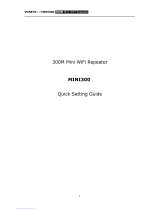SITE PLANNING AND CONSIDERATIONS
DECT deployment assessment is essential to determine elements necessary to achieve the overall
expectations of the user. This includes site survey, determination of type and architecture of the building
along with considering interference factors and finally the estimated traffic in the covered area. The following
sections will cover in more details most of these considerations.
Wireless Range
The DP750 base station sends the wireless signal in all directions making the wireless coverage in a ring
shape.
The wireless range of a DP750 base station and DP760 Repeater are the following:
- Up to 50m indoors.
- Up to 300m outdoors.
Obviously with obstructing objects the range is less than the above values.
Notes:
- For better synchronization between the base and the repeater, we highly recommend a wide
overlapping area.
- Also for better signal quality, we recommend installing the DP750 unit horizontally with LEDs facing
towards usage area. For example, if you mount it on the ceiling, it is better to have LEDs face down.
Site Survey and Interference Factors
Site survey is the process where a number of requirements and information are collected from the user as
well as any conditions that may affect the network and that should be considered during the deployment.
Begin the site survey by interviewing the user representative familiar with the full expectation of coverage
and performance of IP DECT phone solution. While asking for the following requirements:
• Planned radio coverage area.
• Capacity in terms of the number of users, handsets and connections.
• Known problem areas and what to do about them.
• Any future change on the building.
• Expected traffic behavior (hours of high density).
• Also, it is recommended to request a building plan to help in the planning process.
Another criterion that should be taken into consideration during information gathering is the interference
factors, which includes the type of material existing on the coverage area and the potential existence of
neighboring wireless signal sources and networks which can affect the performance of the planned DECT
telephony system.

















